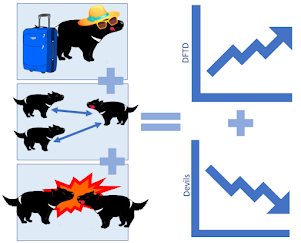Wallace Coffee Talks - Autumn 2020
1st December - 2pm - Online (Zoom)
Fancy a cup of coffee or tea and learning more about the researchers at Swansea university? Come join us at the Wallace coffee talks: an informal seminar series where students, staff and others related to Swansea university speak about their research or personal interests.Rowan Durrant
Modelling a transmissible cancer epidemic
Devil facial tumour disease (DFTD) is a transmissible cancer
of Tasmanian devils. Despite only being first observed in 1996, DFTD has now
spread over most of the island of Tasmania and has caused devil population
sizes to decline by up to 90%. Models of disease can be useful tools for
predicting disease trajectory and evaluate mitigation strategies, but currently
most models of DFTD are restricted to the local spatial scale. We created an
individual-based metapopulation model that allowed us to investigate what
drives a regional outbreak, and to test out a potential DFTD management method.
Our findings show that DFTD-devil coexistence lies in a fine balance of
within-population mixing, disease transmission rates and long-distance
dispersal, and that DFTD management attempts can have potentially adverse outcomes
for devil populations.
Charlotte Christensen
Quantifying grooming budgets in wild chacma baboons (Papio ursinus) using tri-axial accelerometers
Non-human
primates spend a considerable part of their day grooming. These sociopositive
interactions have been linked to both social benefits (increased tolerance,
coalition support) and physiological benefits, e.g. lower physiological stress
levels through modulation of hypothalamus-pituitary-adrenal (HPA)-axis
activity. Accurately quantifying the total time invested in grooming
simultaneously for multiple individuals in a group, throughout day- and
night-time is an impossible task for a human observer. For my PhD, I used
tri-axial accelerometers (Daily Diaries) which recorded data
continuously for 24 hours/day to obtain grooming budgets from chacma
baboons (Papio ursinus). Using machine learning (random forest models),
receiving and giving of grooming was identified with high accuracy (>79%)
and recall (>78%). Whilst self-grooming has been identified from
acceleration data in other species, this is the first-time social grooming
(allogrooming) has been successfully identified and quantified for a primate
species. Using absolute grooming budgets in combination with non-invasive
hormone sampling, I aim to test hypotheses on the proximate mechanisms underpinning
the link between sociality and HPA-axis activity.

